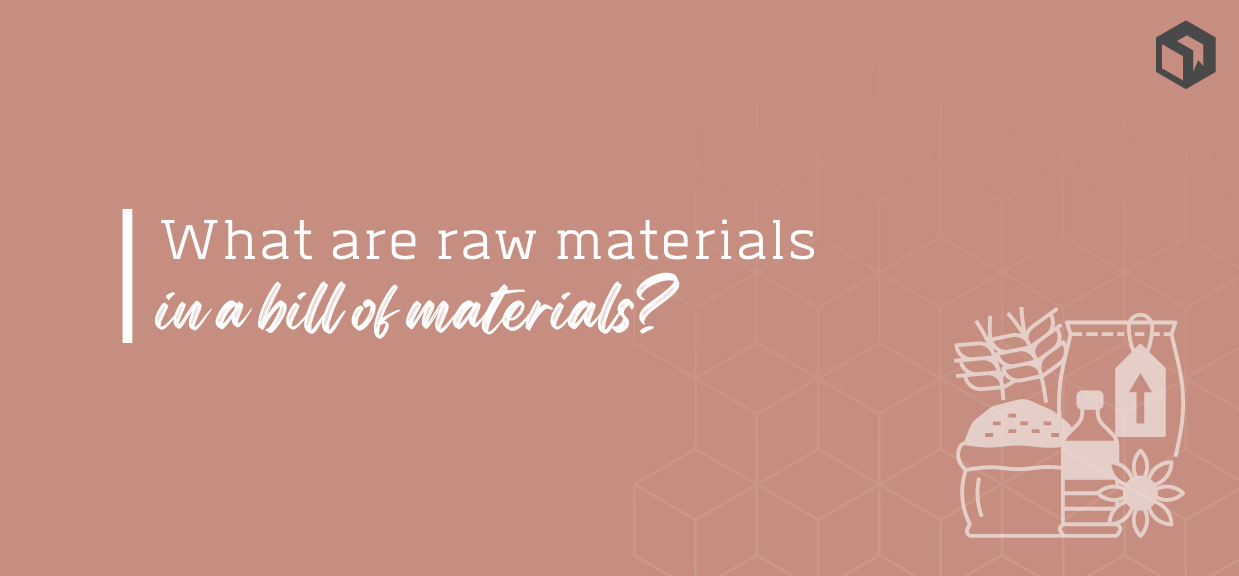What are Raw Materials? A Guide for Manufacturers.
If you are a small manufacturer, it is important to understand what raw materials are and how they are used in a bill of materials (BoM). This article covers the basics of raw materials and includes some tips on how to streamline your operations.

In the manufacturing world, there are a lot of terms and phrases that can be confusing for those who are not familiar with them. One such misunderstood term is “raw materials.”
In this article, we’ll define what raw materials are and how they can be applied to a Bill of Materials (don’t worry - we’ll also cover what this is at the same time if you were wondering about this one too!).
We’ll also cover why it’s important to track your raw materials as part of your production process.
Need to get your raw material and product inventory under control?
Try Craftybase - the inventory and manufacturing solution for DTC sellers. Track raw materials and product stock levels (in real time!), lot and batch tracking, COGS, shop floor assignment and much more.
It's your new production central.
So, let’s get started!
What are raw materials?
?](/static/blog/posts/what-are-raw-materials-b19fda4273457cb0dd5f97b260ef765902bf2f9c78aafe51518aa58b7de540959e3a4af8da0b6d417596dc73ed07f65b29843f2bffb3de3301f484fd49c21f5f.png) So, what does “raw materials” mean? In short, raw materials are materials or substances that are used in the manufacturing process to create a product.
So, what does “raw materials” mean? In short, raw materials are materials or substances that are used in the manufacturing process to create a product.
In this context, “raw” denotes that the material has not been processed or changed since you received it into your supply chain. It doesn’t necessarily mean that it has not been modified and constructed in a previous process before you purchased it.
Raw materials can be anything from clasps, fabric, and lumber to metals to chemicals - they obviously can differ based on your industry and manufacturing process.
They are also commonly referred to as:
- “ingredients” (this is usually used in food production)
- “stock” (usually used when looking at inventory levels)
- “unprocessed material” (again, to denote that the material has not yet been through a production process inside your manufacturing flow)
Indirect vs. Direct Raw Materials
Once you have a grasp of what a raw material is, you’ll want to note that these are categorized into two main types: indirect and direct.
Direct materials
Direct materials are simply a subset of raw materials that specifically refers to the materials that become part of the final product.
For example, if you were making a cake, some of the direct materials would be flour, sugar, eggs, etc. These materials are completely consumed in the making of the cake.
Indirect materials
On the other hand, there are also indirect materials. These are materials that are used in the manufacturing process but don’t become part of the finished product.
Some examples of indirect materials include:
- packaging
- cleaning supplies
- office supplies
To further illustrate the difference between direct and indirect materials, let’s say you run a small furniture business and you want to make a coffee table.
The direct raw materials you would need for this project would be wood, screws, nails, sandpaper, paint, and varnish. These are all materials that you will use to create the final product - the coffee table.
The indirect raw materials you may need for this project may be cardboard and foam, to securely package the coffee table for shipping to the customer. These raw materials are not involved in producing the finished product itself, however, they are used as part of the packaging process.
Read more about the difference between direct and indirect expenses
How are raw materials different to sub-assemblies?
You might be wondering how raw materials differ from sub-assemblies. After all, both are used in the manufacturing process and become part of the final product, so what’s the difference?
The main distinction is that raw materials are used to create sub-assemblies. So, while a raw material can become part of the final product, a sub-assembly cannot.
Confused? Let’s use an example to make this clearer.
Say you were making a pair of shoes. The direct materials would be things like the leather for the upper, the fabric for the lining, and the soles.
The raw materials would be things like the chemicals used to treat the leather, the thread used for stitching, and the glue used for bonding.
The sub-assemblies would be things like the upper (which is made from direct materials), the lining (also made from direct materials), and the insole (made from a combination of direct and raw materials).
Sub-assembly processses can be designed and tracked using multi-level BOMs.
Why is it important to track your raw materials as a small manufacturing business?
It’s really important for any business that manufactures products from raw materials to ensure that they have a robust system for tracking their raw materials inventory.
If you don’t track what raw materials you have on hand, it can be difficult to know what you need to order and when. This can lead to production delays, unhappy customers as well as extra costs associated with rush shipping or expedited fees.
There are many other benefits of tracking your raw materials, including:
Improved production planning and coordination: By understanding what raw materials you have on hand, you can better plan and coordinate your production. This can help you avoid manufacturing delays and disruptions.
Reduced risk of stock outs and production delays: By tracking your raw materials, you can avoid stock outs and production delays. This is because you will always know what raw materials you need and when
Increased visibility into the manufacturing process: Tracking raw materials can give you greater visibility into your manufacturing process. This can help you identify bottlenecks and optimize your process.
More accurate bookkeeping and financial reporting: Tracking raw materials can also help you with your bookkeeping and financial reporting. This is because you will have a more accurate picture of your inventory and what it is worth.
Streamlined inventory management: Tracking raw materials can help you streamline your inventory management. This is because you will have a complete picture of what raw materials you have on hand and what you need to order. This can save you time and money.
As a small manufacturing business, tracking your raw materials is essential to ensure that you are in control of your complete supply chain.
How are raw materials used in a bill of materials?
Let’s now cover how raw materials are used in a Bill of Materials.
Before we do, let’s briefly take a look at what a Bill of Materials is. A Bill of Materials (aka “BoM”) is a list of all the raw materials, components, and required to build a product.
This list includes the finished products and sub-assemblies, what type of raw material is needed (i.e. wood, fabric etc.), how much is needed, who the supplier is, and any other pertinent information.
Raw materials are used in a bill of materials to build products and sub-assemblies. The bill of materials includes the finished product, what type of raw material is needed, how much is needed, who the supplier is, and any other pertinent information.
Interested in learning more about how to create your own bill of materials?
- What is a Bill of Materials? Examples for small manufacturers
- How to creating a BoM in 7 simple steps
How are raw materials tracked in bookkeeping?
In bookkeeping, raw materials are typically tracked in your accounting balance sheet as inventory. This is because, like finished goods, raw materials are a physical product that the company owns.
When a company purchases raw materials, this is recorded as a credit to the Accounts Payable account and a debit to the Inventory account. When the raw materials are used in manufacturing, they are then transferred to the Work in Progress inventory account.
Finally, when the product is complete and ready to be sold, it is then moved to the Finished Goods inventory account.
As you can see, tracking raw materials through the manufacturing process can be quite complex. However, it is essential for ensuring that your business has a clear understanding of what materials it has on hand, what is needed to complete production, and when products will be finished and ready for sale.
If you manufacture products from raw materials, chances are you already have some sort of system in place to track your inventory. However, if you’re still using manual methods like paper spreadsheets or even a whiteboard, it might be time to consider upgrading to a perpetual inventory software solution.
Perpetual inventory software is designed specifically for businesses that need to track inventory levels in real-time. This means that as soon as a raw material is used in production, the software will automatically update the inventory records.
Not only does this make it easier to keep track of what materials you have on hand, but it can also help prevent errors in your bookkeeping.
Using MRP software to track your raw materials
If you find that tracking your raw materials manually is proving to be too complex and time-consuming, you may want to consider using MRP software.
MRP (Material Requirements Planning) software is designed specifically for manufacturing businesses and can automate many of the tasks associated with managing inventory. This includes things like creating and updating BOMs, generating purchase orders, and tracking material usage.
If you are a small manufacturer that is looking to streamline your operations, MRP software may be a good solution for you.
Craftybase is MRP software that includes bill of materials and perpetual inventory tracking. Craftybase is designed for small manufacturers to take control of their inventory and streamline their operations.
With Craftybase, you can easily create and update your BOM, generate purchase orders, and track material usage. This gives you a clear understanding of what raw materials you have on hand, what is needed to complete production, and when products will be finished and ready for sale.
In addition, Craftybase offers a free 14 day trial so you can try out the software before committing to it. So if you are a small manufacturer looking for an MRP solution, be sure to check out Craftybase today.
